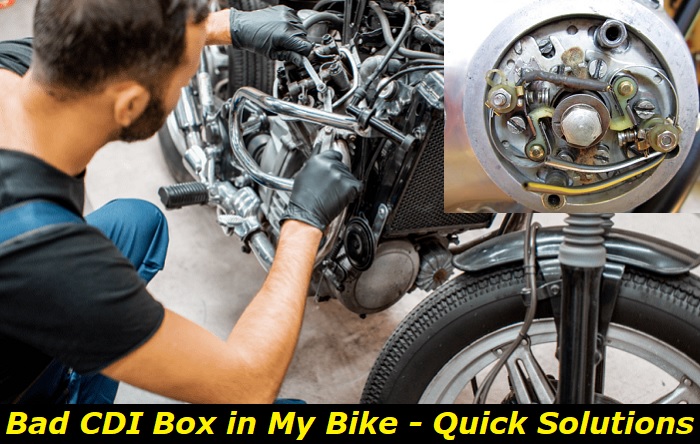Motorcycle manufacturers have for many years now installed electronic ignition systems in these two-wheelers. An ignition system in your motorcycle is designed to ignite the air/fuel mixture inside the engine. Such an ignition system has to send the right amount of voltage into the engine's combustion chamber at the right time. CDI ignition system is predominantly the ignition system installed in bikes today.
In this article, we look at the signs to look out for when you suspect your motorcycle's CDI box is faulty. We will explore the tricks and methods you should use to restore a bad CDI. Let us look at how it functions first to appreciate why you must take a keen interest in your motorcycle's CDI ignition system.

What is a CDI ignition system?
CDI stands for Capacitor Discharge Ignition. It is also referred to as the thyristor ignition in some quarters. The CDI system is very common in modern motorcycles and is also found in many 3-wheel motorcycles, some cars, and boats.
In 1906, the first car, Ford Model K, was equipped with a CDI box. After numerous improvements, electronic CDI boxes were quite common in the 1950s. However, this electronic CDI ignition involved multiple moving components, making it prone to breakages. Many years of research and testing finally saw the electronic CDI box become a common ignition system in motorcycles and other machines by the 1980s.
The CDI box, as it is commonly called, controls a motorcycle's ignition system by starting the ignition and, after that, the combustion process in the engine. Ideally, a pulse of voltage is emitted from the battery which then passes through the CDI box to fire the spark plug. Most motorcycles made after 1980 are equipped with a CDI box. If the CDI box or the igniter box, as it is at times called, doesn't work properly, your motorcycle is going nowhere.
How does CDI box work?
The CDI system starts the ignition in the combustion chamber by using the energy found in the capacitor. This energy is then used to produce a high voltage of up to 300 volts on the ignition valve, creating a spark in the spark plug. The higher the energy at the capacitor, the stronger the spark produced to ignite the air/fuel mixture.
It can be said the CDI box is where the electric current to the motorcycle is distributed from and is cut off. It makes available electric current whenever the engine is turned on and switches the current off when the engine is off.
The CDI system, which can either be using AC or DC power, must be precise in timing. This ensures that the fuel/air mixture is completely burnt. This provides enough heat for optimal energy to the motor system while ensuring that no pollutants get emitted into the environment.
The CDI system includes several components such as the battery, CDI box, motor ignition switch, spark plug, and pulse igniter. Each of these components must be efficient if the CDI box is to deliver effectively. Whether your motorcycle's CDI box is programmable, standard with a racing limiter, or without, the following are the symptoms to look out for when you suspect it is going bad.
What are the symptoms of a bad CDI box?
When your bike develops electrical problems, it can be complicated to pinpoint the issue to a bad CDI box. Troubleshooting power problems in your bike can be tough and expensive. Here are the leading symptoms that should help you troubleshoot CDI box issues in your motorcycle:
- Rough engine running
- Engine stalling
- Misfires
- Difficulty starting
- Dead cylinder
- Backfiring at high RPMs
As pointed out earlier, it is not easy pinpointing a CDI problem. Any of the above-stated symptoms could be due to several reasons that have nothing to do with the CDI box. Jumping to the conclusion that the CDI box is bad might lead you to incur unnecessary expenses and waste precious time. It is for this reason that you should have ample knowledge of the mechanics of a motorcycle or just involve a professional.
To help you finally know whether your CDI box is faulty, it is important that you first do a series of tests on the following CDI system components:
- Wiring- corroded, torn, and worn-out wires can lead to the CDI box not functioning as intended. Check the wiring of the ignition system, especially the ground wires.
- The battery- This test is done using a voltmeter to confirm that the battery has the proper voltage. Check the terminals for gaps and whether there is any corrosion.
- Rectifier/ regulator- The rectifier, which is the charging control device that rectifies the power output from the alternator/ACG and also controls the voltage of the voltage transfer, should also be tested. To test the regulator, you will need a multimeter.
- Fuse- The main fuse is known to blow out regularly. If the fuse is blown out, investigate the problems that might be causing it to get damaged first. It is advisable to always have a spare fuse in your toolbox.
- Stator- The stator, which works the same way as the alternator, charges the bike's battery while the bike runs. CDI system issues could be due to a faulty stator. Check the stator's resistance and voltage while it is plugged in to check for any power issues.
- Swap the CDI box- If all the above tests have not helped solve the problem, then it's time you tried swapping the CDI box. At your local dealership, they might have access to a functioning CDI box with which to swap.
A bad CDI box does not always have observable symptoms. At times, a faulty CDI will not cause sparks or a misfire. Remember, a defective fuel pump or spark plug can display similar symptoms as a faulty CDI box. These symptoms can be confusing, and care should be taken before concluding the issue with the CDI. It is essential that you first undertake thorough tests as indicated above.
What should you do when you have a bad CDI?
After conducting all the necessary tests to confirm that it is indeed the CDI box that has an issue, it is now time to look into how to sort it. To test the CDI box, you will need a multimeter. A professional mechanic should undertake these tests to avoid damage to the bike or bodily injury. The process involves three steps which are:
- Remove the CDI box from the bike. You should allow the box to sit for at least 30 minutes to allow the internal capacitance to discharge fully.
- Testing the CDI box is the next step. This step involves visually inspecting the box to confirm the damage is not external or visible. In this testing stage, conduct a cold test with the multimeter, which tests for continuity.
- The third test should be the 'hot test'. A hot test is an alternative method of testing the CDI box while still connected to the motorbike. To conduct this test, you should use the blue and white wire from the CDI box. The resistance of the blue wire should be 77 ohms, while that of the white wire should be 85 ohms.
After conducting these tests, it should be possible to identify and locate the problem making your CDI box malfunction. Upon opening the CDI box, you will find a motherboard circuit that carries capacitors, resistors, fuses, and wires. Many riders opt to repair their faulty CDI boxes rather than automatically replacing them with a new one. Look for a mechanic that is well qualified to handle a faulty CDI box.
Sometimes, all that is wrong with your CDI box can be a blown-out capacitor. While this can easily be replaced, there can be damage that might not be worth trying to repair. Some riders have reported that upon repairing a CDI box they experience the same CDI problem after a few weeks. This is why you will need an expert that can professionally advise you on whether to repair or replace.
If all tests conducted above point to a bad CDI box, it is recommended that you replace it. This is if the CDI box is irreparable. In most cases, you can replace a CDI box at home. CDI box prices vary widely depending on the model and make of your bike. The price can be as low as $30 or as high as $1,000, depending on the type and model of the bike. This cost does not include labor which is charged per hour at many garages.
Conclusion
The CDI box is a critical component in the ignition process of your bike. As a rider, it might help if you invest in knowing what the CDI system does and how the various components are interconnected. This way, you will easily understand what to check whenever the bike shows the symptoms described above.
It is worth noting that being oblivious to the workings of the CDI box can cause an otherwise small issue to grow and force you to replace the whole box and possibly other components.
About the authors
The CarAraC research team is composed of seasoned auto mechanics and automotive industry professionals, including individuals with advanced degrees and certifications in their field. Our team members boast prestigious credentials, reflecting their extensive knowledge and skills. These qualifications include: IMI: Institute of the Motor Industry, ASE-Certified Master Automobile Technicians; Coventry University, Graduate of MA in Automotive Journalism; Politecnico di Torino, Italy, MS Automotive Engineering; Ss. Cyril and Methodius University in Skopje, Mechanical University in Skopje; TOC Automotive College; DHA Suffa University, Department of Mechanical Engineering






Add comment